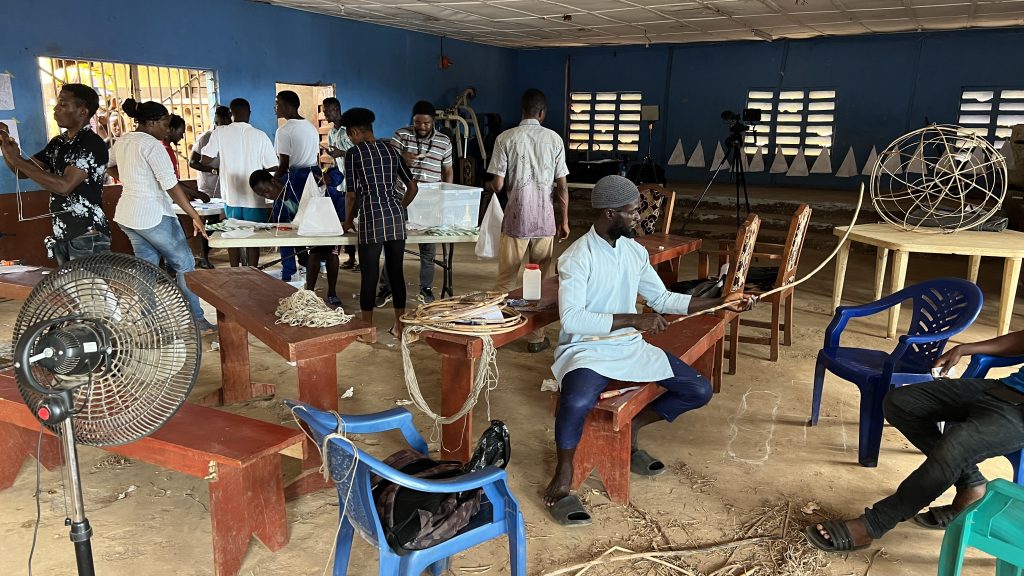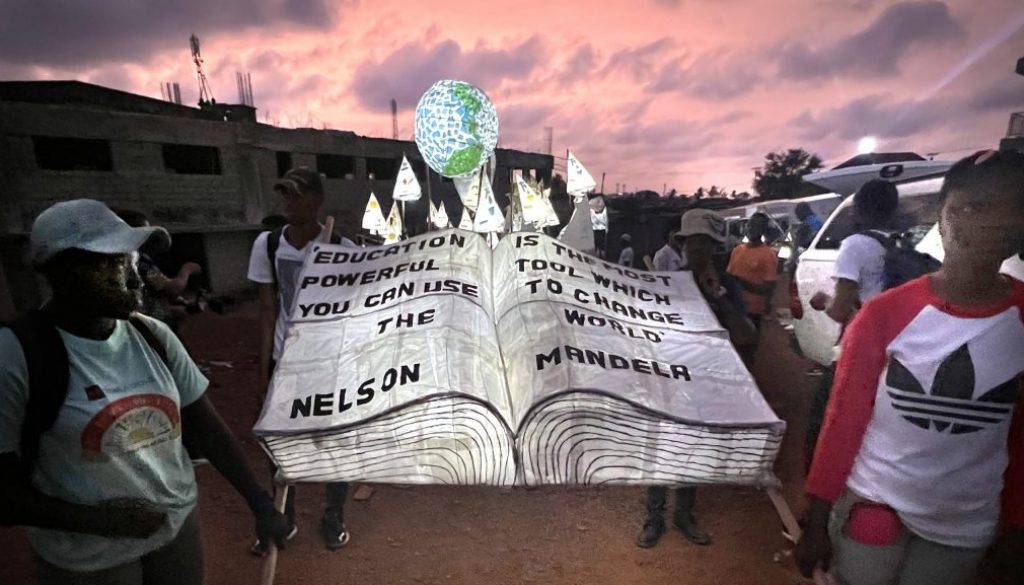Communicating research through art: ‘Power of Light’ case study in Dwarzark, Freetown
Ibrahim Juldeh Sesay, Samira Sesay, Samuel Saidu, Ibrahim Gandi, Abu Conteh and Hayley Stewart report on the Power of Light case study in Freetown, Sierra Leone, where art facilitated communication of research.
As informal settlements continue to gain recognition in research and policy discourses, there is also a growing interest in using arts-based methods to engage with communities, going beyond traditional research outputs and engagement. The aim is to make research content more relatable and accessible to audiences who may not connect to more traditional research engagement methods. Some examples of these more traditional methods and outputs include journal articles, briefs, blogs or workshops that rely on verbal or written communications centred on complex and technical content. Despite growing interest in using art to facilitate community engagement, many research projects and funders have yet to find ways to demonstrate their research in this way. In ARISE we used the Power of Light, a collaborative art project, to discuss ARISE research findings, while also showcasing the ingenuity of community residents in tackling their health and well-being challenges through art.
An opportunity to showcase our research
The Power of Light project, funded by the Liverpool City Council and Luke Jerram (an internationally renowned UK-based artist) is a continuation of the ARISE community-based participatory research approach. ARISE has been working with co-researchers to ensure community participation in the various phases of the research process. However, communicating complex research outputs such as publications and briefs at the local level has continued to be a challenge. We identified key ARISE findings we wished to share with communities, including information on climate change, disasters, safety and security, basic services and health and well-being.
Arts-based approaches are a significant and effective way of communicating research to communities, particularly when engaging a broad and diverse audience on complex or sensitive topics or when specific communities may not find traditional research outputs accessible. Recognising the relevance of art-based approaches, ARISE saw this as an opportunity to give power to the local community to highlight the issues they feel are important – this time through a partnership with the artist Luke Jerram and the Liverpool City Council. With the involvement of local artists and co-researchers, 21 solar-powered lights were also installed across three communities, and light sculptures were produced with ARISE messages written on them.
The aim of the Power of Light project was to install these solar-powered lights and design light sculptures to reflect the challenges, needs and priorities of residents in local communities, and share findings from ARISE research. Through designing and creating light sculptures of water taps, the globe, the sun, a heart, a light bulb and a book, local artists represented the needs of the community.

Involving residents
Equity and inclusivity in research processes have always been central to ARISE’s approach. Through the Power of Light project, we demonstrated how resourceful community residents can be in contributing to research processes and addressing their health and well-being challenges. We recruited ten local artists from the Dwarzark community to co-create light sculptures with support from Luke Jerram and ARISE co-researchers.
Luke Jerram and his team provided training for local artists, co-researchers and researchers on the design, development and delivery of the approach. The inclusion of local artists in the design of lantern lights and light sculptures enhanced research equity and collaboration with community residents. We recruited local artists based on their local residence in the community, artistic knowledge and evidence of their work. Having members from within the community participate in the design, and delivery of the lantern parade was a deliberate effort from the Sierra Leone ARISE partners as the aim was not just to communicate research outputs through art, but to also create capacity-building opportunities for community residents whose role is central to ARISE.
We worked with local electricians and co-researchers to install permanent solar-powered lighting around public areas such as water collection areas, the fish jetty, the cinema, the community centre the community field etc. The idea for the installation of solar-powered lights was to enhance safety and security and improve people’s ability to work and continue their education after dark.
Artistic Outputs

Once the lights were installed and the sculptures made, a parade was organised to showcase the artwork and celebrate the switch-on of the newly installed lights. With a local band leading the way, the sculptures were paraded at dusk through the community by the local artists who made them. They were then displayed at the community field, where a meal was shared with everyone involved in the celebration. At the end of the lantern parade, the sculptures were donated to the community chief, the health centre, and the police station. LED lights were also donated to local children who had taken part in the lantern parade, which they could use to study at night. Luke and his team worked with ARISE researchers and co-researchers to make a documentary, capturing the making of the sculptures and lanterns and the parade as well as messages from local residents and researchers about the importance of light in overcoming local challenges. The documentary, as well as the lanterns and sculptures, reflected the interests, experiences, values, and beliefs of local people living in informal settlements.
Integrating art-based approach in research processes
Art-based approaches can work best in facilitating a local-level understanding of complex traditional research outputs among illiterate residents. For example, through the Power of Light project, we demonstrated, through the creation of symbolic light sculptures, how the provision of light links to the health, well-being and safety of local communities. Environmental and health and well-being challenges that were necessarily obvious to some residents and local authorities were made plain during the lantern parade, through the messages of the light sculptures. When aiming to empower communities with information, an art-based approach will enhance local communities’ understanding of their challenges as well as harness their skills and capacities to tackle those challenges. This was demonstrated with palpable clarity throughout the Power of Light project.
Photo credits: Luke Jerram
